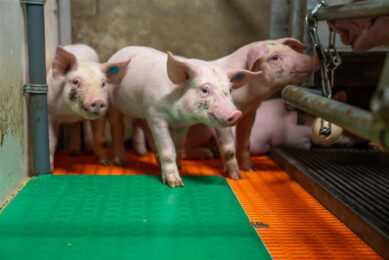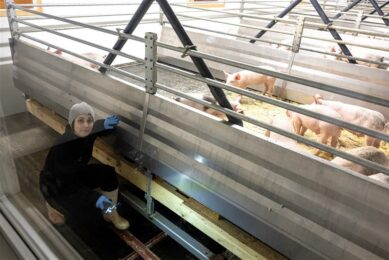Group housing requirements lead to market turbulence

At the edge of the new century the European Commission ?adopted the directive on the protection of farming animals. For pigs, group housing for gestating sows is a well-known outcome. The directive is likely to influence market prices for pigs. How much?
In the European Union, group housing is now required for gestating sows from four weeks after insemination until one week before the expected farrowing. Other requirements of the EU legislation include floor quality, living area (like 0.65 m2 per fattening pig up to 110 kg; 2.25 m2 per pregnant sow) and slat width of concrete slatted floors. Pigs must have permanent access to a sufficient quantity of material to enable proper investigation and manipulation activities, such as straw, hay, wood, sawdust, mushroom compost, peat or a mixture of such. Also requirements are given towards craftsmanship of the people working with the pigs. Farm staff must have knowledge of the welfare requirements.
January 2013
In February 2013, an official overview of the implementation of group housing in the different countries was given, see Table 1 . The official data show that ten countries have fully implemented group housing for pregnant sows. Several countries are almost ready, but some still have a longer way to go. Combined with the sow numbers per country, it is estimated that by 1 January, 89% of the sows comply with the group housing requirement. There are however, serious doubts about the given figures. Germany for example is estimated a much higher rate of compliance by experts, whereas there are doubts regarding countries like Italy, Spain or eastern member states. A 80-85% rate of compliance seems therefore more realistic.
Stricter national provisions
Since the legislation is part of a European directive, member states may adopt stricter national provisions. This can lead to additions or minimal deviations. The majority of member states however, has adopted the requirements unchanged.
The directive distinguishes sows that have (sows) or have not yet farrowed (gilts). The area requirements for gilts are about 25% lower than for farrowed sows. The Netherlands has levelled up to the highest size for all sows and obligates group housing from four days after insemination already. Austria adopted, under serious societal pressure, higher requirements, in which sows from ten days after weaning have to be group housed. That is more or less comparable to the Dutch demand. The Austrians further require loose farrowing systems; which is obligated after renovation or at least from 2032. Also in Sweden farrowing sows must be free to walk around in the pens, already now. And in Sweden a complete slatted floor is forbidden, while a straw layer is demanded for all categories of pigs.
Also the area requirements for finishing pigs show differences. The Netherlands chose a minimum of 0.8 m2 with 40% solid lying area for a finishing pig of up to 110 kg live weight. Germany demands 0.75 m2 , Austria 0.7 m2 , but Sweden requires 1.02 m2.
Belgium however, demands a natural light inlet surface for at least 3% of the floor area. Germany too, demands a minimum of 3% window area if possible and light intensity must be at least 80 lux. All pigs in Germany must have access to rooting material.
The area per pregnant sow in Denmark depends on the number of sows in the group. In groups up to 18 sows, the area per sow is higher than the EU requirement. The length per side of the sow pens must be at least 3.0 metres. Solid floor requirements are in place, where rearing piglets must have a minimum of 50% and finishing pigs a minimum of 33% solid floor and rooting material must be available. Tail docking is allowed only between two and four days of age and for a maximum of half of the tail.
The United Kingdom claims to have high welfare standards. The country, however, only demands that all non-lactating sows are group-housed (so immediately after weaning). The slat-width of concrete slats for finishing pigs is typically ¾ inch (19 mm), which is tolerated by the European Commission.
A complete comparison of all the different national implementations is complicated. It is not possible to really compare the welfare standard per country, particularly because welfare-oriented measures are not the same as a real welfare improvement for the animals. It is however clear that Sweden is the front-runner with welfare measures.
Although the United Kingdom and Sweden were in the front-row by demanding group housing for pregnant sows over ten years ago, this did not help their pig sector.
The stricter demands have brought higher costs to pig farmers, but costs were insufficiently compensated. In the UK, farmers got a rather good market price, but this showed to be inadequate due to high feed prices and low performance levels in pig production. Meanwhile the self-sufficiency in both countries decreased, due to a lack of competitiveness compared to neighbouring countries. From this point of view it is understandable that several other countries aim for level playing field.
Economic consequences
The biggest cost of implementing the EU directive can be found in the area requirements and labour intensive measures like application of straw. In addition to this, a short transition term for investments can have drastic economic consequences. The reduced size of the pig sectors in Sweden and the UK are typical examples. Being in the forefront can be fatal to the pig sector. A production shrink can lead to loss of critical size, forcing reductions in related industries and services.
What are the economic effects in other countries? The group housing requirements must not be very expensive, provided that farmers can fit the adaptation into their common investment rhythm. The EU directive had already been known for more than ten years, so for farms that showed a healthy development pattern, this was feasible. The extra area needed per sow can (partly) be found by increasing the group size and saving pen separations. Many of the welfare oriented measures have a temporary effect. A pig farmer must get accustomed to it and the pigs as well.
Group housing was not desired in the Netherlands in the 1990’s; fortunately there were positive experiences as well. Nowadays in fact every pig farmer can work well with group housing, all the more since there are different systems available. Every change can also have some good outcomes. If electronic identification is being used in group housing, this can be used for improved animal management and more efficient feeding. A bigger area for finishers improves the daily gain. It seems that if an animal feels more comfortable, it performs better as well. So attention to the animal’s welfare has also shown to be in the interest of producers.
Enforcement approach
Brussels has clearly indicated that all farmers must comply. The European Commission learnt from the situation with laying hens, where cages were forbidden from January 2012. Many poultry farms in several European countries did not comply in time, by reconstructing towards enriched cages. Brussels has learnt to put more effort in enforcement. Before 2013, member states were requested a few times to give an overview on the degree of compliance and to indicate what national governments planned to do in order to enforce timely compliance. The European Commission has little opportunities to enforce; national governments are in charge here.Theoretically the EU can impose market restrictions on meat from finishers that were born on farms where the pregnant sows not were housed in groups.
However, the indirect way and the necessary complex traceability system restrains this. It was easier with the laying hens: Eggs are marked according to their production system and those produced in a conventional cage system were not allowed to be sold as eggs for consumption.
Two systems
The approach to stimulate and enforce group housing differ between member states. Basically there were and are two systems: Publicly (national government) and privately (via quality systems or companies). A governmental approach is used for example in the Netherlands, in cooperation with farmers’ representatives. In the autumn of 2012 the state inspection agency sent a letter to all sow farmers to inform them on the enforcement approach and asked them to indicate whether there would be a problem to comply in time.
All farmers having difficulties with complying in time were paid a visit in January 2013. If a farm was not fully compliant a so-called ‘provisional order for penalty payment’ was issued, which is meant as a warning to adapt immediately, rather than to really expect payment. This governmental approach is also used in Spain. In the autumn of 2012 farmers were told to no longer inseminate sows in non-compliant systems, with a warning that from 2013 piglets born in such systems would be killed. It is however doubted if this threat will be practiced.
In Denmark and Germany, non-compliant farms are to be excluded from the national quality system (the Farm Assurance Scheme in Denmark and the QS system in Germany). This probably means a somewhat lower market price for slaughter pigs born as piglets on a non-compliant farm, but this could not be confirmed yet. Part of the enforcement in Germany is that the regular veterinarian (who is obliged to visit a farm twice a year), together with the farmer, signs a statement with regard to compliance.
Reduction in sow numbers reach 10%
It may be expected that the number of sows will decrease further in 2013. This is not only to compensate for increasing piglet production per sow, but also because a part of the farms does not fully comply with the rules. Farmers are not able to raise funds for the needed reinvestments and are thus forced to quit production.
A lot of effort is made by farmers in many countries. Even France, with a compliance rate of only 72% reports to fully comply within a few months. Major drivers are that smaller producers with a lack of funding quit production, in combination with political pressure from Brussels.
BPEX, the British interest organisation of the meat and livestock sector, assume a 5-10% reduction in sow numbers in 2013, compared to 2011, mainly in southern and eastern European countries. Although the average performance per sow will increase (since reduction seems to hit especially the lower performing countries), a reduction is expected in the production of slaughter pigs. This means that the price for slaughter pigs will increase. The recent strong price increase in August 2012 shows that the price is strongly influenced by the ratio between offer and demand. A reduction in sow numbers is seen already.
The degree of shrinkage however depends on the efforts of enforcement and an even stronger shrink than 10% is (at least theoretically) conceivable. In that case, the EU would not be fully self-sufficient and imports from outside the EU would be necessary. The World Trade Organization (WTO) does not allow the exclusion of meat imports from outside the EU with the argument of lower welfare standards. It can thus happen that meat is imported from systems that are not allowed in the EU. Furthermore, the production cost of non-European competitors like Brazil or the US is cheaper than within the EU. Therefore it is advisable to prevent dependency on imports from such countries, to prevent cheap meat pressing the European pig meat market.
Given the firmly increased feed prices many pig farms in the EU have little funds to re-invest towards group housing. A possible solution for farmers to comply in a very short term would be to reduce the number of sows by about 20%; also the cage equipment must be opened or removed and the floor must be made partly solid. The pregnant sows would then have sufficient space and probably comply. However, such a partial reduction is economically undesirable.
Fixed costs (depreciation, interest, labour) continue, but must be borne by a lower production volume. However, it is conceivable as an emergency measure.
Especially in low-compliant countries many farms are expected to stop operating. This will stimulate the growth of continuing farms. It will also strengthen the development of Denmark and the Netherlands to be the farrowing room for Europe, whereas finishing shifts towards the east. In many eastern European countries there is cheap labour and ample environmental room. Competitive piglet production is only possible with excellent craftsmanship and with knowledge of veterinarians, and research.
Market will find a balance again
The effect of lower production on prices strongly depends on the speed and size of the reduction. Let’s assume that from 1 January, all sows that were inseminated lived on compliant farms. From May the piglet supply would firmly diminish and the piglet price increase strongly. Accordingly the supply of slaughter pigs would diminish from July or August and the price would increase substantially. This scenario is not likely, due to rather weak enforcement. Enforcement is not equally strict and quick in the member states. If a reduction would happen during the first half of 2013, the piglet price, and slaughter pig price consequently would increase gradually. A price increase as a consequence of the group housing requirement will therefore not happen before autumn of 2013.
An increasing piglet price will be curbed by two factors: Re-expansion of the sow numbers (that will not happen in the short term) and a correction from the finisher side. Finisher farmers usually transfer a negative profit partly to their piglet suppliers.
However, since the market price for slaughter pigs probably increases, due to a limited supply, we assume a positive profit outlook both for sow farmers and finisher farmers. Again, this depends on the enforcement efforts. Strong efforts will have stronger effects on supply and prices than moderate efforts.
It is however, quite sure that a reduction in pork production in Europe will be followed by expansion of pig numbers and meat production. Although the required group housing will lead to serious fluctuations in supply and prices, a new balance will be found.











